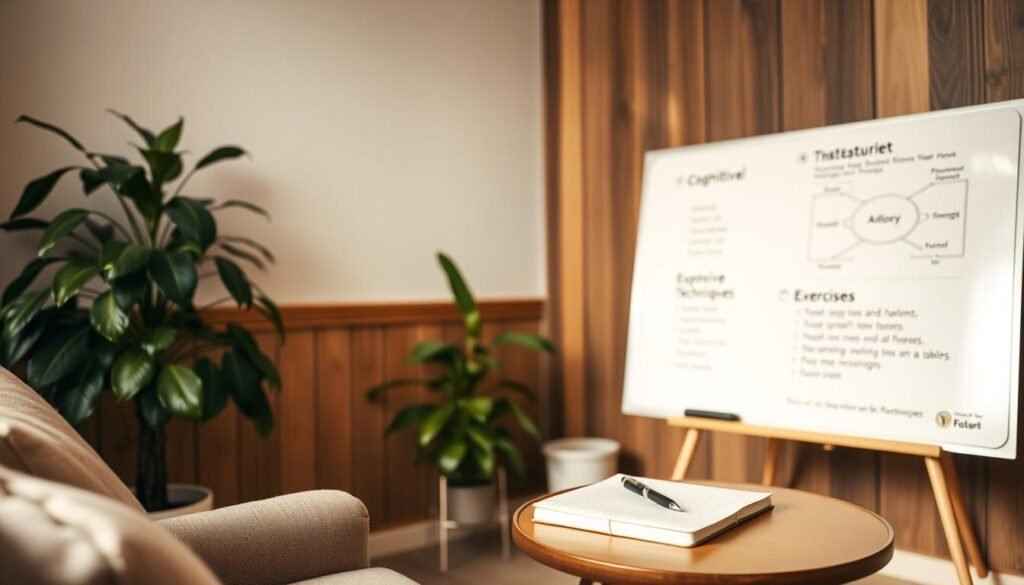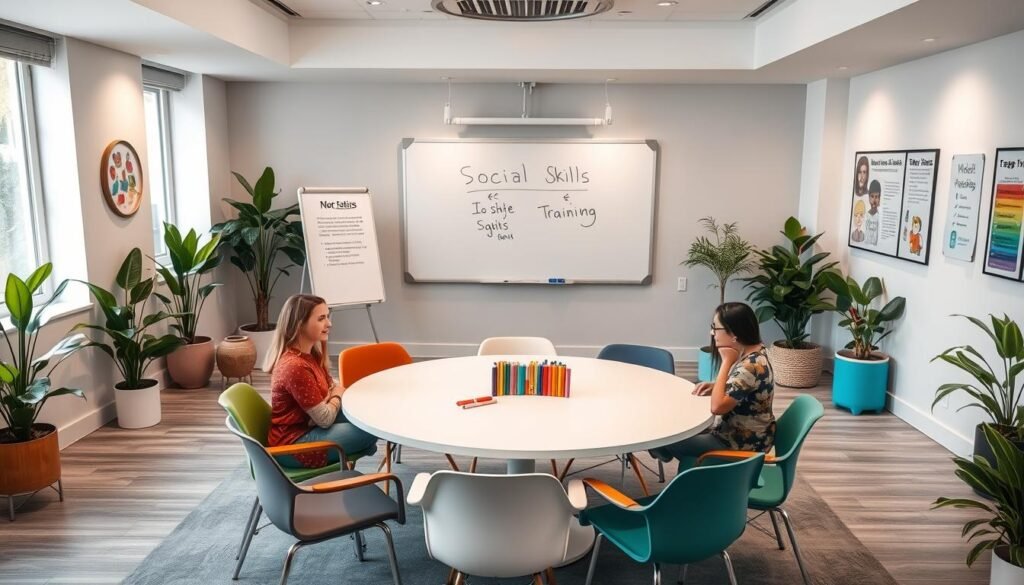Over 12% of adults experience social anxiety disorder in their lifetime. This means millions face intense fear and avoid social settings. But, there’s good news. Cognitive Behavioral Therapy (CBT) is highly effective for treating this disorder. It provides tools for anxiety management by targeting negative thoughts. This allows individuals to face their fears step by step.
Not dealing with social anxiety can lead to serious issues. It often results in more depression and substance abuse. Yet, with just 12-20 weekly sessions of CBT, there’s a big chance for improvement. This treatment teaches valuable principles and techniques. They help people take back control over their lives.
Key Takeaways
- The lifetime incidence of social anxiety disorder in adults is over 12%.
- CBT is recognized as the most effective treatment for social anxiety disorder.
- Most people respond well to CBT within 12-20 weekly sessions.
- Untreated social anxiety disorder can lead to increased depression and substance abuse.
- Exposure therapy is a major component of CBT but is underutilized by some therapists.
- CBT can also effectively treat other anxiety disorders, enhancing overall mental health.
Understanding Social Anxiety Disorder
Social Anxiety Disorder (SAD), also known as social phobia, involves a deep fear of social settings. People with this disorder worry a lot about others judging them. It’s important to know the symptoms of social anxiety to get the right help.
Definition and Symptoms
SAD causes a strong fear of being in social situations. Those with it fear others’ judgment, avoiding social events as a result. The common symptoms of social anxiety include:
- Extreme self-consciousness
- Fear of public speaking or being in social places
- Physical signs like sweating, blushing, and shaking
- Staying away from places with social interactions
To accurately diagnose social anxiety disorder, seeing a mental health expert is advisable. They can offer the right assessment and treatment options.
Impact on Daily Life
The effects of social anxiety on everyday life can be large. Many with SAD pull away from loved ones. They miss out on professional growth and struggle in making new friends. This affects their ability to interact confidently.
About 7% of U.S. adults have SAD. Without treatment, it can last for years and seriously harm life quality.
What is Cognitive Behavioral Therapy (CBT)?
Cognitive Behavioral Therapy (CBT) is a way to change negative thoughts that cause stress. It uses different methods to help improve your mental health. These techniques help people with many types of psychological issues, like social anxiety disorder (SAD).
Overview of CBT Techniques
At the heart of CBT is cognitive restructuring. This technique helps people find and change wrong thoughts. By doing this, individuals replace negative beliefs with more accurate views. CBT includes a variety of strategies.
- Cognitive restructuring
- Exposure therapy
- Behavioral experiments
- Mindfulness practices
These strategies are adaptable to meet each person’s needs. This makes CBT more effective for treating social anxiety.
Effectiveness of CBT in Treating Anxiety
Studies show that CBT really helps with anxiety disorders. It improves how well people function and their quality of life. CBT works as well as, or better than, other treatments or medicine.
About 5% of adults worldwide have social anxiety disorder. Studies show that CBT, especially using both cognitive restructuring and exposure techniques, helps reduce symptoms.
| Techniques | Description | Effectiveness |
|---|---|---|
| Cognitive Restructuring | Identifying and reframing negative thoughts. | High success rates in shifting thought patterns. |
| Exposure Therapy | Gradually facing feared social situations. | Proven to reduce anxiety and avoidance. |
| Mindfulness Practices | Focusing on present thoughts and feelings. | Enhances emotional regulation and awareness. |
CBT is a key method for treating social anxiety disorder and improving emotional well-being.
Social Anxiety Disorder Cognitive Behavioral Therapy
Cognitive Behavioral Therapy (CBT) is key in fighting social anxiety. It uses special techniques. Two main ones are cognitive restructuring and exposure therapy. These methods aim to change negative thoughts and help people face their fears. As a result, individuals get better at handling tough situations and feel stronger emotionally.
Cognitive Restructuring Techniques
Cognitive restructuring starts with spotting wrong beliefs about social moments. It involves questioning thoughts like “Everyone will laugh at me”. Then, it replaces them with more positive views. For example, realizing not every interaction leads to shame. This change in thinking lets people see their fears more clearly. It helps them be more confident in social settings.
Exposure Therapy Explained
Exposure therapy means gradually facing social fears. With this therapy, people face real or imagined stressful situations. They start with easier ones and get used to handling their nerves better. Studies show this method reduces worry about future social interactions. This success makes exposure therapy a great tool in CBT treatments.
| Technique | Description | Effectiveness |
|---|---|---|
| Cognitive Restructuring | Identifying and modifying negative thought patterns. | Enhances emotional resilience and coping strategies. |
| Exposure Therapy | Gradual confrontation of feared social situations. | Substantially reduces anxiety and increases confidence. |
For more on CBT strategies, visit the National Social Anxiety Center. They have lots of info and can connect you with expert therapists in the US.
Common CBT Techniques for Social Anxiety
Cognitive Behavioral Therapy (CBT) uses several methods for managing social anxiety. Important techniques include cognitive defusion, mindfulness, and behavioral experiments. These methods improve resilience against anxiety.
Cognitive Defusion
Cognitive defusion helps people not to get overwhelmed by negative thoughts. It teaches viewing anxious thoughts as temporary, not facts. This helps lessen their emotional effect.
With this technique, individuals can face social situations more clearly. Detaching from negative thoughts reduces anxiety significantly.
Mindfulness Practices
Mindfulness is a key CBT technique against social anxiety. It involves staying in the moment without negative judgment. This reduces anxiety significantly.
By being mindful, people understand their thoughts and feelings better. Accepting these moments helps reduce social anxiety over time.
Behavioral Experiments
Behavioral experiments are practical tests against irrational social fears. They involve facing social situations and observing the outcomes. Often, these outcomes show that initial fears were baseless.
These experiments build positive social experiences. They show that social settings can be less scary and even fun.

How CBT Helps Overcome Shyness
Many people find it hard to overcome shyness when they have social anxiety. Cognitive Behavioral Therapy (CBT) plays a key role in this challenge. It offers ways to spot and deal with the negative thoughts that stop people from being social and growing.
Identifying Negative Thought Patterns
At the start, therapy helps people see their negative thinking. This thinking might make someone avoid social scenes for fear of embarrassment. By understanding these negative thought patterns in social anxiety, clients can begin to change their outlook and develop a healthier mindset.
Challenging Irrational Beliefs
Then, people work on fighting these false beliefs. With special activities and talks, they face their fears and start thinking positively. For example, they learn to swap “I’ll embarrass myself” with “I can talk to others and be okay.” Challenging irrational beliefs in CBT changes harmful self-talk into positive thoughts. This boosts self-confidence and helps clients handle social situations better.
If you want to learn more about these strategies, check out this detailed guide on CBT’s success with social anxiety.
Building Confidence with Social Skills Training
Social skills training is key for treating anxiety in cognitive behavioral therapy (CBT). It focuses on improving social skills for people with social anxiety disorder (SAD). By participating in structured activities, individuals can better their social engagement and grow their confidence. They practice talking and interacting, which helps enhance their social experiences.
Importance of Social Skills in CBT
The role of social skills in CBT is crucial. People with social anxiety miss many chances to interact, which limits skill development. Social skills training offers structured chances for these individuals to practice and learn new techniques. Examples include:
- Behavioral rehearsal to practice social scenarios
- Positive reinforcement following successful interactions
- Instruction on nonverbal cues and active listening
- Weekly homework assignments to reinforce practice
This method doesn’t just better interaction skills; it also lowers anxiety by promoting a feeling of ability. Studies show that social skills training, when combined with CBT, brings lasting benefits to those with SAD.
Activities for Enhancing Social Skills
To boost social skills, trainers use various activities. Activities might involve:
- Role-playing social situations for hands-on practice
- Getting corrective feedback to learn from errors
- Trying out conversation starters in relaxed settings
- Teaching how to give and receive compliments to smooth over social moments
- Applying assertiveness methods to build confidence and cut down anxiety

Through these methods, individuals work on handling social anxiety, confidently broadening their social circles. They learn communication techniques and how to deal with emotions in social settings. Taking a well-rounded approach to social skills training is essential for creating positive, lasting change in those facing social anxiety.
Exposure Therapy: Gradual Confrontation
Exposure therapy tackles social anxiety by gently facing fears. This is key in cognitive behavioral therapy (CBT). By easing into scary situations, the process seems less overwhelming. Working with a therapist, one can map out their anxieties. They can list social scenarios from least to most intimidating. This helps start with easier situations, moving on to harder ones later.
Creating a Fear Hierarchy
Building a fear hierarchy means ranking social situations by anxiety levels from 0 to 10. For example, chatting with a friend might be easier than speaking to a group. By knowing what scares you more, you can tackle fears one by one. Successful exposure therapy comes from knowing your limits. This makes overcoming each level feel rewarding.
Strategies for Successful Exposure
For exposure therapy to work, it takes effort and a plan. Some useful strategies include:
- Practicing in real life helps you get used to scary situations.
- Starting simple makes it easier to face tougher challenges later.
- Using relaxation methods can help calm nerves during exposure.
Research shows that about 75% of people with social anxiety disorder see less avoidance after exposure therapy. It’s also helpful for other anxiety issues like panic disorder, with a 70% improvement rate. These results prove that well-planned exposure can help you overcome fears that cause anxiety.
Mindfulness for Anxiety Management
Mindfulness is now key for treating anxiety disorders, especially with cognitive-behavioral therapy (CBT). It focuses on being aware of the current moment. This lets people notice and accept their anxiety without being harsh on themselves. By doing this, they get better at handling uneasy thoughts and emotions.
Using mindfulness, therapy teaches how to calmly notice feelings. This greatly betters how someone feels when talking or being with others.
Defining Mindfulness in Therapy
Mindfulness in therapy teaches people to be more aware and control their emotions better. It makes one look at their thoughts and emotions from a distance, without harsh judgment. Its main goal is to show that feeling anxious is okay. It’s something that can be recognized and controlled, not something to run from.
This change in thinking is very helpful. It teaches self-love and lessens the fear of being in social places.
Methods for Practicing Mindfulness
There are many ways to add mindfulness into therapy. Some great methods include:
- Meditation: By focusing on breathing or certain thoughts, one can be more accepting of the current moment.
- Breathing Exercises: Controlled breathing is good for handling physical anxiety symptoms.
- Mindful Observation: Watching how you interact with others mindfully helps understand emotions without judgment.
- Body Scan: This helps become aware of physical feelings, linking them to emotional states.
Adding mindfulness to CBT offers people great tools for dealing with anxiety. It improves their life in social places significantly. Mindfulness makes clients emotionally healthier and less anxious.
Combining Self-Help Techniques with CBT
Mixing self-help with cognitive behavioral therapy (CBT) for social anxiety can greatly boost the effectiveness of treatment. It lets people practice methods on their own, beyond therapy. This way, they gain a deeper insight into their anxious thoughts and actions. Using tools like workbooks, readings, and online classes alongside professional help is very useful.
Resources for Self-Help
There are many resources available to aid in self-help for social anxiety, including:
- Workbooks: These are filled with exercises that help reinforce what CBT teaches.
- Online Courses: These courses offer lessons on how to handle anxiety better.
- Support Groups: They provide a space to share experiences and try new skills together.
- Mobile Apps: These apps give exercises and reminders for practicing relaxation and cognitive strategies.
Working with a Therapist vs. Self-Directed Therapy
Though self-help strategies are helpful, working with a therapist on CBT is often key for full treatment. Therapists can deal with complex feelings and customize strategies for each person’s needs. On your own, you might miss the deeper guidance needed to challenge wrong beliefs and use exposure techniques right. Knowing the limits of self-help is important in addressing social anxiety.
Signs You Should Seek Professional Help
Knowing when to get professional help for anxiety isn’t easy. But seeing the key signs is vital for timely help. If you often feel scared and it messes with your day, it’s a big sign. Understanding when to get help is the first step towards feeling better.
When Anxiety Becomes Untreatable
Sometimes, anxiety gets so bad that nothing you do on your own helps. You might feel anxious all the time and avoid seeing people. You might feel really down or get sick often. Using things like alcohol to feel better can also be a sign.
If this sounds like you, it’s important to talk to a professional about your anxiety. They can help you learn how to handle it. For more on how anxiety impacts you around others, check out this resource.
Importance of Professional Guidance
Getting help from a pro is key when trying to beat anxiety by yourself doesn’t work. Therapists have the right skills and know treatments that do work. Going to therapy can help you deal with tough thoughts and get better at handling stress.
Therapy also helps with other problems like feeling really sad or using drugs too much. Having a good plan for treatment helps a lot. Knowing when to get help is important to start making a change. If you have headaches or feel very tired, it might be time to get help. With the right support, you can feel better.

Conclusion
CBT for social anxiety has strong support from research and clinical trials. This method is seen as the best for treating anxiety disorders. It offers significant benefits and works well in studies.
With tools like cognitive restructuring and exposure therapy, people can face their fears. They can make their lives better.
For those dealing with Social Anxiety Disorder (SAD), it’s important to get involved in treatment. This includes self-help and professional therapy. Understanding your condition and using CBT principles is vital.
Taking these steps helps individuals gain confidence. It also helps them build stronger relationships with others.
The journey to manage SAD includes special strategies and regular practice. With proper support, beating social anxiety is achievable. It can even lead to significant personal improvement and strength.